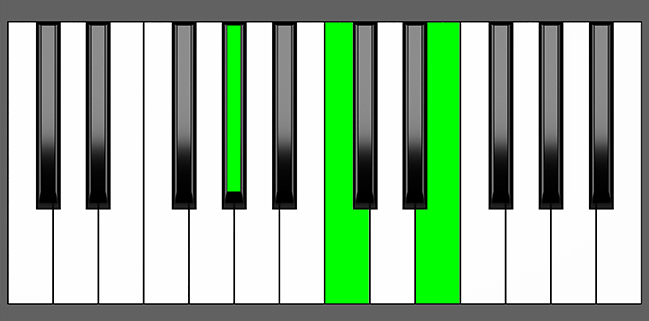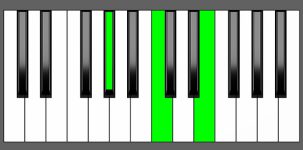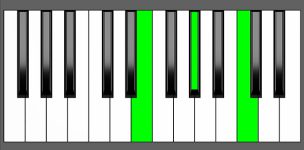Piano Diagram of Ab aug in Root Position

An Ab augmented chord is an augmented triad built upon the key of A-flat. To get an Ab augmented chord, you combine the root (Ab), the major 3rd (C), and the sharp 5th note (E) from the A-flat scale. Keep reading to get a better grip on the music theory behind this chord.
Structure of Ab aug
Notes |
|---|
| Ab, C, E |
Intervals |
|---|
| R, 3, #5 |
Fingers Position
Left Hand |
|---|
| 4, 2, 1
5, 3, 1 |
Right Hand |
|---|
| 1, 2, 4
1, 3, 5 |
Ab aug Chord Inversions
Ab aug has a total of 2 inversions:
| Root Position: | Ab | C | E |
| 1st Inversion: | C | E | Ab |
| 2nd Inversion: | E | Ab | C |
Piano Keyboard Diagrams
Inversions Equivalencies
One interesting feature of augmented chords is that each inversion of the chord produces a different augmented chord. For example, if you take the first inversion of an Ab augmented chord (which means you play the notes in a different order), you get a C augmented chord. And if you take the second inversion of an Ab augmented chord, you get an E augmented chord.
So, you only really need four different augmented chords to cover all the possible keys, because all the other augmented chords can be found by inverting these four chords.
| Distinct aug Chords | Notes | Root Position | Enharmonic Inversions | |
|---|---|---|---|---|
| C aug | C – E – G# | C aug | E aug | G#/Ab aug |
| C# aug | C# – E# – Gx | C#/Db aug | F aug | A aug |
| D aug | D – F# – A# | D aug | F#/Gb aug | A#/Bb aug |
| D# aug | D# – Fx – Ax | D#/Eb aug | G aug | B aug |
Notice how each of the four distinct augmented chords contains a unique combination of three notes, which can be rearranged into three different chord inversions. By utilizing these four chords and their inversions, it’s possible to cover all 12 keys. Keep in mind that the selection of C, C#, D, and D# is arbitrary, as you could use any other series of unique augmented chords to build them all.
Music Theory and Harmony of Ab aug
Augmented chords are found on the III degree of both the melodic and harmonic minor scales, where they should function as a mediant chord. However, they are not used in this position. Instead, they are more commonly used as a leading tone towards a major or minor tonic chord.
F Melodic Minor Scale
| i | ii | III | IV | V | vi | vii |
| F min | G min | Ab aug | Bb Maj | C Maj | D dim | E dim |
F Harmonic Minor Scale
| i | ii | III | iv | V | vi | vii |
| F min | G dim | Ab aug | Bb min | C Maj | D dim | E dim |
But before we explore the chords that can follow an Ab augmented chord, let’s take a closer look at how to construct one.
Building the Ab aug Chord: Different Approaches
Starting from the Ab Major Scale
Keeping as reference the major scale, build the augmented chord, which consists of the Root, major 3rd, and sharp 5th.


- Start from the root note A-flat.
- Add the major 3rd C.
- Raise the 5th note Eb by one half-step to get E.
- Combine the root note (Ab), the major 3rd (C), and the augmented 5th (E) to form the A augmented chord.
You can apply the formula R, 3, #5 to build any augmented chord.
by Combining 3rds
An augmented triad is a chord consisting of two stacked major 3rds.
3 + 3 = aug Chords
To build an augmented triad on A-flat, start with the root note Ab, and then add a major 3rd interval above it to get C. Finally, add another major third interval above C to get E. The resulting Ab augmented triad would consist of the notes Ab, C, and E.
How to Use Ab aug in a Chord Progression
Augmented chords can be used in different ways. One of the most common ways they’re used is through substitution, which means they can take the place of other chords. For example, augmented chords can be used as a substitute for dominant 7th chords. Additionally, they can also work as passing or transitional chords between other chords.
Most of the time, an augmented triad functions as a variation of the dominant chord that resolves on a tonic chord five degrees under its root. However, it is worth mentioning all easy transitions possible starting from an Ab aug. The harmonic structure of augmented chords makes it possible to get many different chords just by shifting any of its notes by a half step, let’s see why:
Resolving Ab aug to Major and minor Chords
An augmented chord is made up of notes that are separated by a specific and constant distance from one another. In the case of an Ab augmented chord, the notes Ab, C, and E are separated by a “major 3rd” interval.
It’s important to note that each note in the Ab augmented chord can act as a leading tone to transition to another chord that sounds good in the progression. This is because changing one of the notes in the augmented chord can create a different type of chord altogether.
To form a major chord, you need to combine a “major 3rd” interval with a “minor 3rd” interval. Conversely, a minor chord is formed by using a “minor 3rd” interval followed by a “major 3rd” interval. Therefore, when you play an augmented chord, you can use each note in the chord to lead to a different type of chord, such as a major or minor chord, by changing the distance between the notes.
Lowering One Note: from Ab aug to Major Chords
The table below shows how lowering each note of the Ab aug chord can lead to three different major chords:
| aug Chord | Lowered Note | Resolving Chord | Chord Shape |
|---|---|---|---|
| Ab C E | Ab | G C E | 2nd inversion of C Maj |
| C | G# B E | 1st inversion of E Maj | |
| E | Ab C Eb | Root position of Ab Maj |
If you lower one note in the A-flat augmented chord, you will end up creating a major chord from each of its notes. So Ab aug can transform into:
- Ab Major or
- C Major or
- E Major
Lowering Two Notes: from Ab aug to minor Chords
Lowering two notes of an aug chord results in several minor chords. Let’s explore which minor chords can be derived from the Ab aug:
| aug Chord | Lowered Notes | Resolving Chord | Chord Shape |
|---|---|---|---|
| Ab C E | C, E | Ab Cb Eb | Root position of Abm |
| Ab, E | G C Eb | 2nd inversion of Cm | |
| Ab, C | G B E | 1st inversion of Em |
Lowering two notes of an augmented chord creates three minor chords with the same root as the inversions of the augmented chord. This means that Ab aug can transform into:
- Ab minor or
- C minor or
- E minor
This can be useful in minor keys where the v degree is played as a V7 chord (borrowed from the harmonic minor scale). In this case, the Ab augmented chord can replace Ab7, C7, and E7 in minor keys.
However, the best fit for Ab augmented is to substitute Ab7. When it’s played in place of C7 or E7, it’s actually an inversion of the better fit, C augmented and E augmented, respectively.
Raising One Note: from Ab aug to minor Chords
When you raise one note of an Ab aug chord, you get minor chords. The following table shows the three different minor chords that can be created from an Ab aug chord:
| aug Chord | Raised Note | Resolving Chord | Chord Shape |
|---|---|---|---|
| Ab C E | Ab | A C E | Root position of Am |
| C | G# C# E# | 2nd inversion of C#m | |
| E | Ab C F | 1st inversion of Fm |
When we raise one note of an Ab augmented chord, we get:
- A minor or
- C# minor or
- E# (F) minor
Raising Two Notes: from Ab aug to Major Chords
Similarly, raising two notes of the Ab aug chord results in several major chords. Let’s take a look at which chords can be formed:
| aug Chord | Raised Notes | Resolving Chord | Chord Shape |
|---|---|---|---|
| Ab C E | C, E | G# C# E# | 2nd inversion of C# Maj |
| Ab, E | A C F | 1st inversion of F Maj | |
| Ab, C | A C# E | Root position of A Maj |
When we raise two notes of the Ab augmented chord, we can resolve it to three different chords:
- A Major or
- C# Major or
- E# (F) Major
When an Ab augmented chord resolves to a Db major, it is functioning as the V+ (augmented fifth) degree in the key of Db major. This is the most common use of the Ab augmented chord as a substitute for the Ab7 chord, which creates a strong sense of tension and resolution in the context of a Db major key.
In the keys of F or A major, Ab augmented can replace the V+ chord which is C and E augmented respectively. This is possible because Ab aug is an inversion of C aug and can be used instead.
Similarly, E aug, which is an inversion of Ab augmented, can also be substituted, but it’s usually better to use the augmented chord with the same root of the dominant chord instead of using an inversion.
Ab aug as Dominant Chord
As we have seen, Ab aug can be transformed into various minor and major chords simply by raising or lowering one or two notes. These tables show all the possible resolutions of the Ab augmented chord in major and minor keys, where it can be substituted for the V chord in a ii-V-I/i progression.
Try these progressions and experiment with playing both the augmented and the dominant chords, or just the augmented chord. You can also try playing the dominant chord first, followed by the augmented chord, or vice versa.
| Ab aug in Major Keys | ||||
|---|---|---|---|---|
| Key | V degree | Substitution | ii V I |
ii V+ I |
| in Db Major | Ab7 | Ab aug as Dominant (V+) | Ebm | Ab7 | Db Maj | Ebm | Ab aug (Ab7) | Db Maj |
| in F Major | C7 | Ab aug as Inversion of C aug | Gm | C7 | F Maj | Gm | Ab aug (C7) | F Maj |
| in A Major | E7 | Ab aug as Inversion of E aug | Bm | E7 | A Maj | Bm | Ab aug (E7) | A Maj |
| in G Major | D7 | Tritone substitution | Am | D7 | G Maj | Am | Ab aug (D7) | G Maj |
- When an Ab augmented chord resolves to a Db major, it is functioning as the V+ (augmented fifth) degree in the key of Db major. This is the most common use of the Ab augmented chord as a substitute for the Ab7 chord, which creates a strong sense of tension and resolution in the context of a Db major key.
- In the keys of F major, Ab augmented can replace the V+ chord, which is C augmented. This is possible because Ab augmented is an inversion of C augmented that substitutes the C7 chord.
- Similarly, E augmented, which is also an inversion of Ab augmented, can be substituted, but it’s usually better to use the augmented chord with the same root of the dominant chord instead of using an inversion.
- The tritone substitution: By replacing a dominant 7th chord with another chord whose root is a tritone away, we can create a new harmonic color while maintaining the original function of the dominant chord. In the case of Ab augmented it can be used as a tritone substitution for D7 because the distance between Ab and D is a tritone (six half steps).
| Ab aug in minor Keys | ||||
|---|---|---|---|---|
| Key | V degree | Substitution | ii V i | ii V+ i |
| in Db minor | Ab7 | Ab aug as Dominant (V+) | Ebø | Ab7 | Db min | Ebø | Ab aug (Ab7) | Db min |
| in F minor | C7 | Ab aug as Inversion of C aug | Gø | C7 | F min | Gø | Ab aug (C7) | F min |
| in A minor | E7 | Ab aug as Inversion of E aug | Bø | E7 | A min | Bø | Ab aug (E7) | A min |
The Ab augmented chord can serve as a substitute for the dominant 7th chord in minor keys. It is a common practice to use a dominant 7th chord instead of the minor dominant chord typically found in natural minor keys. This substitution is derived from the harmonic minor scale and is widely used in natural minor key progressions.
Since the Ab augmented chord shares the same notes as C augmented and E augmented, and because augmented chords can substitute for the dominant 7th chords built on their roots, it follows that Ab augmented, being an inversion of both C augmented and E augmented, can be used to replace C7 and E7 in their respective keys. However, it’s better to play the augmented chord with the same root as the dominant chord rather than playing an inversion.
Ab aug Voice Leading
Ab augmented can serve as a chromatic passing chord, allowing for smooth voice leading. It can also function as a pivot chord to modulate to a new key or be used as a substitute for the dominant chord to create a sense of tension and eventual resolution.
| I | ii | iii | IV | V | vi | vii |
| Ab Maj | Bb min | C min | Db Maj | Eb7 | F min | G dim |
I I+ IV
| I | I+ | IV |
| Ab Maj | Ab aug | Db Maj |
I I+ iv
| I | I+ | iv |
| Ab Maj | Ab aug | Db min |
I I+ VI
| I | I+ | vi |
| Ab Maj | Ab aug | F min |
I I+ ii V
| I | I+ | ii | V |
| Ab Maj | Ab aug | Bb min | Eb7 |
Ab aug as Chromatic Modulation
Using the Ab aug chord for chromatic modulation can add an interesting tonal color to your music. It is a popular technique used to add interest to a series of static measures on a single chord.
I I+ I6 I+ I
| I | I+ | I6 | I+ | I |
| Ab Maj | Ab aug | Ab6 | Ab aug | Ab Maj |
Alternative Names for Ab aug
- Ab+
- Ab+5
- Abaug
- Ab(#5)
- Ab(5#)
- Ab(5+)
- Ab(#5+)
- Abaug5
- Ab(5aug)
- Ab(+#5)


